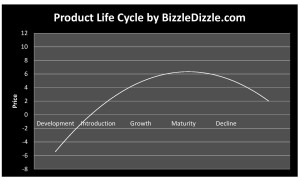Each product goes through four defined stages. The duration of time spent in these stage depends on the product and the niche. Some products are very quick to gain popularity, but soon reach maturity and decline quickly. For example fashion accessories – a celebrity wears a bracelet, sales rocket, but it is forgotten within a year.
The stages of the Product Life Cycle are:
Introduction
Growth
Maturity
Decline
These are plotted on a graph of sales vs. time:

Introduction
During the introduction phase of the product life cycle, the product is introduced, marketed and sales begin. In this period ‘early adopters’ buy the product. These tend to be the people who have a specific interest and follow the niche closely e.g. the fashion conscious for fashion items or technology savvy individuals in the fast past electricals market (including mobile phones).
The sooner a product enters the introduction phase, the sooner a price can be established and development costs reimbursed. Frequently an element of market skimming is used where prices are initially higher and then adjusted to one which suits the business and meets consumers expectations and perception of value exchange. In all markets there are many factors affecting the market price. For example, how much of the mobile phone market is actually influenced by fashion and emerging tastes rather than technology.
Growth
The growth stage is where the manufacturer or distributing business expands sales quickly and aims to increase market share, thus dominating the market and ensuring that any lagging competition does not establish the same foothold within the niche. During this stage, demand increases quickly as the product becomes known by the masses rather than just those with specific interests. There tends to be no major competition, especially if the product is innovative.
Maturity
At this stage, sales plateau. This does not mean that sales necessarily slow, but the fast increase seen during the growth stage levels off for a period of time. This is where the majority of the market purchase the product, price tends to be well established and does not fluctuate much. Increases in sales at this stage can be by add-on features, special offers or packages offering extra value and appeal.
Decline
At this stage of the product life cycle, all the people who were going to buy the product in numbers have made a purchase. Sales begin to dwindle and often a price needs to be reduced or other incentives added to delay the negative sales progression. Sales and ‘specials’ can be used to attract the rest of the market, who are also termed the laggards. Some products undergo value engineering to make the product appear to have a new incarnation with better, stronger or ore powerful features than the original. Often these techniques can sometimes rejuvenate some sales from the group seen in the introduction and early growth periods.
Read more about marketing. Do not confuse this with the project life cycle, which is project related (internal business process) rather than related to a specific product or range.